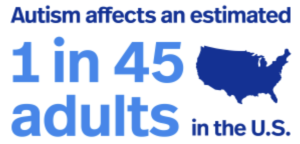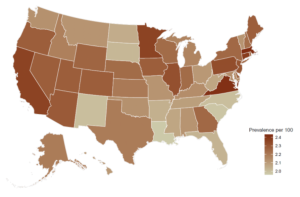It’s the evergreen HR question: how can employers fully leverage the highest potential of a strong workforce?
Having their employees be the best they can is the obvious answer, but often employers find it difficult to manage those who have different reactions to sensory inputs.
So what do I mean by this? The fact is, everyone is different.
One person might not be able to tolerate the itchiness of a wool sweater, the other may have no problems with it at all.
Or what about loud music? For one person, they might be overwhelmed it, for the other it’s something they enjoy and actually helps them concentrate.
A third person might get headaches from certain kinds of light bulbs; for others it’s something they don’t even thing about.

Source: www.autismspeaks.org

Estimates of state prevalence of adults with autism (Springer.com)
Work is a place full of distractions
The fact is everyone will have to face many different sensory inputs, and for the most part, people have tools to cope with them. However, at times those inputs can be overwhelming and cause extreme discomfort.
Sensory processing differences are typical symptoms for people with autism.
Sensory differences can also be possible for people with anxiety, ADHD or PTSD.
Interestingly, these diagnoses are increasing.
In 2023 the Center for Disease Control and Prevention reported an increase in autism prevalence, which has been rising over the past 20 years.
Recent studies show that ADHD rates are increasing across age groups.
Anxiety rates have also increased over the past decade, especially for younger Americans.
As more of the population copes with autism, anxiety, ADHD or related mental health disorders, it is reasonable that sensory concerns may also be on the rise overall.
As such, businesses and organizations will reach a broader audience, customer base and workforce by considering the following sensory-friendly accommodations:
Create a sensory-friendly office space:
Those with particular sensitivities may be overstimulated by background noise. Open-plan workspaces and even cubicle set-ups can result in a loud working space, with competing noises. Employees may benefit from headphones or noise-canceling headphones. Businesses may also offer a calm, quiet space for employees to work or even to take a break.
Overhead lighting, especially fluorescent office lighting, can be too bright and make may buzzing sounds. Many employees prefer lamps or natural lighting. As an alternative, it’s a good ideas to ask facilities teams to instead install incandescent lights or add fluorescent light covers.
Other sensitivities may be related to certain fragrances or strong fragrances. Many offices choose to be fragrance-free environments.
Offer virtual or flexible accommodations:
Some employees with sensitivities may work better or more efficiently under different circumstances. They may require modifications to or additional options within the dress code.
So, rather than modifying the physical office environment, it may be easier to allow some employee to set up their own preferred working space and to work with these employees remotely.
Include accessible outings:
When your company leaves the office, how accessible is the destination?
Whether the reason is for happy hour, team-building, or to be out in the community, consider how the environment may impact people with sensitives.
For example, consider whether the venue will be loud, crowded, and have bright lighting.
Consider whether it will be difficult to navigate to the venue. Additionally, will the venue offer sensory accommodations for guests?
It may be OK to bring your company to loud, crowded venues, though also showing up occasionally in more accommodating places ensures that people with sensory concerns have a location to visit.
Publicize your accommodations:
Accommodations aren’t of much use if customers and employees are unaware of the option.
Highlight the adaptations using easy-to-find physical signs in your space.
Include them in an obvious part of your website and social media as well.
For events, showcase the accommodations in the event info or FAQ. For some employees, this information will be the difference of whether they interact or not.
Integrate accommodations into your operations:
Your company may already have accommodation ready.
But, if your staff doesn’t know how to provide these accommodations, then the accommodations aren’t readily available.
Ensure that not only that your business is accessible, but that these options are integrated into your standard business operations, so that your employees are familiar with the process.
Provide social narratives:
Adults with sensory processing differences benefit from having more available information about what the place they will be in for working or teambuilding with colleagues will be like.
What does the space look like? What is the schedule and flow of the place? Provide photos of the parking lot, the inside of the space, and any notable visuals may be helpful.
Visual or social narratives, or step-by-step guides describing a place, help employees know what to expect and prepare appropriately.
Request feedback:
Check-in with employees and other stakeholders through various means to see what other accommodations would resonate and be appreciated.
A variety of check-ins can be valuable, ranging from in-person conversations to social media comments and anonymous surveys.
Reevaluate your accommodations:
Just as a business or organization’s goals may change over time, the same may happen with the customer base or workforce.
Periodically reconsider whether the current accommodations are still achieving the intended result, or what might be changed to ensure your business is still accessible.
